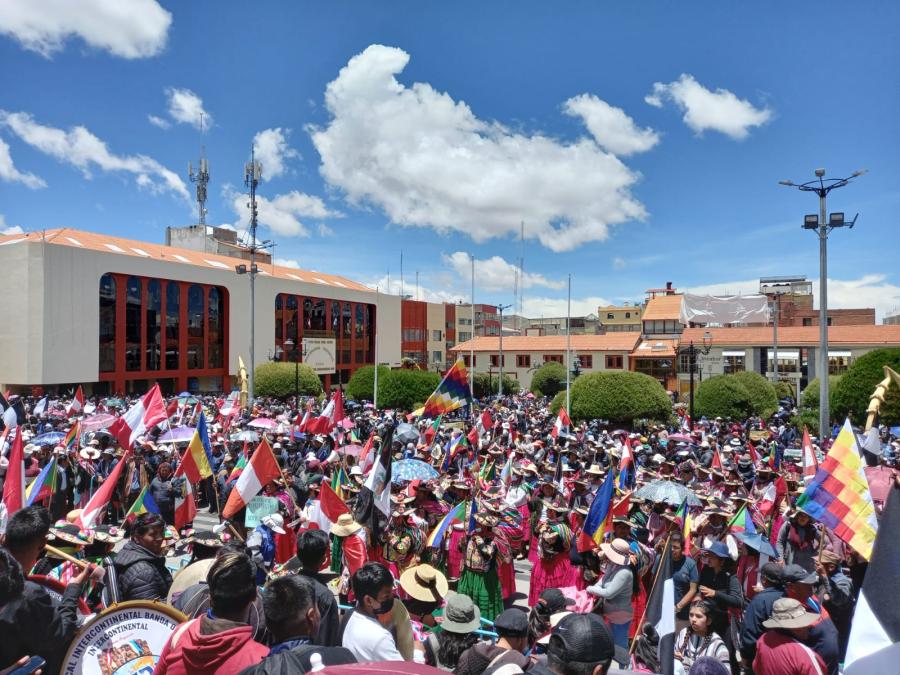THE search for domestic peace in Peru has never been more obscured by uncertainty and contradiction. As the present government teeters at the edge of its capacity to manage a guerrilla movement, the "Sendero Luminoso" (Shining Path) seeks adherents among the swollen ranks of the estimated 30-40% unemployed and the legion of underemployed.
In the past 40 years, Peru's population has tripled, rising to nearly 18,000,000 at an average annual increase of almost 3%. Peru's governmental, political, economic and social structure has not been able to satisfy the emerging requirements of society. Until 1969, 4% of landowners held 81% of the land. Although such concentrations of productive assets have been ameliorated in part, 40% of the people earn but 6.9% of the income; 10 percent receive 43% of it.
Even with the sweeping changes of the past decade, the distribution of wealth, well-being, skill and power grossly favors Peru's new urban elite. Lima now holds about 30% of Peru's citizens; overall, the country is 67% "urban." This complete reversal of Peru's demographic traditions in a two-decade period is provoking drastic changes in society, culture, politics and economy.
In Peru social and cultural worth and access to resources has always been associated with "urbanness." Peruvians understand that the best is only available in Lima, and second best in some other large cities (Doughty, 1979]. Thus, massive rural-to-urban migration is an attempt to acquire material goods and social status through proximity association. By the mid-20th century, two factors - schooling and industry - contributed to unprecedented urban growth.
The emergence of the commercial fishing industry along the coast raised Peru to first place in world fishing. Thousands of highlanders swarmed coastward to work in the 1,450-vessel fleet and in over 600 processing plants which sprang up to cash in on the bonanza fishmeal industry. The primary qualifications for such workers were that they be male, speak some Spanish and be functionally literate.
This was a change from a traditional pattern of labor migration which drew farm workers into low paying, seasonal, manual jobs such as sugarcane cutters and cotton pickers on coastal plantations. Private contractors brought in "50 head" of workers in a truckload committing them to work out the harvest.
While tough and demanding, jobs in the fishing industries paid phenomenal wages by Peruvian standards - sometimes as much as 200 dollars a week. Such weekly earnings exceeded annual incomes of whole families! Chimbote, Callao, Supe and other Pacific ports swelled as aggressive mountain people arrived daily by the truck- and busload.
Earlier in this century, migrants were overwhelmingly male, 15 years or older. Today women also fill the migrant ranks. Well over half become domestic servants in urban centers.
Culturally, recent population shifts reinforced the authority of the nation state, the use of the Spanish language and cholo behavior. Few migrants consider themselves "Indians," although many come from families who might.
Coastal employment opportunities permitted highly motivated and talented highlanders access to cash. The fruits of one's labor on the coast are carried back to the hometown in the form of new clothes, cameras, blenders, beds, and recently, television sets. In the most remote of villages the visitor may be greeted by someone wearing a "California University" sweatshirt, thong sandals made in Hong Kong or a T-shirt that advertises "Adidas." The thirst for industrial goods of any quality is closely related to labor mobility, migration and urbanization.
It has often been speculated that this movement of Indians as peasants represents the "ruralization of the city." While this may be the case demographically, what is more striking is the steady advance of the urban culture, values and social life in rural areas. Television broadcasting of Brazilian and Mexican soap operas, Kojak and Different Strokes, endless advertising, and the Lima news reinforces national and international values. In Spanish, designed for urban consumers, these messages are increasingly absorbed by wondering Andean children, women and men.
Labor migration has introduced a package of contradictions to the cultural identity of highland peasants. On the one hand, the new urbanites acquire city culture - with scarcely a backward glance. They join unions, strike, hustle, and dance the salsa. They become permanent residents by turning their bamboo squatters' huts into brick and concrete houses of substantial proportions. One migrant family I have known for 23 years typifies the cycle of events. Over this time they: moved from a very poor farm (less than two hectares); endured seven years of inner city slum life; took part in a squatter invasion; and today have a substantial concrete house and store in Lima's migrant-created district of Comas. She has worked as a maid, vendor and storekeeper, he as a mechanic and construction worker; they are gaining mobility through their two daughters who are now entering professional life as a medical doctor and a lawyer.
At the same time, however, in Lima and all other large cities in Peru, migrants of all backgrounds constantly organize "provincial clubs" representing their home communities. In Lima there are more than 5,000 such clubs dedicated to glorifying the "homeland," celebrating its festivals, encouraging its development through cash donations, gifts and lobbying. Like "alumni associations," caravans of migrant club members and others return to their native villages for feast days and to exhort their friends to improve their lifestyles and develop the land. Yet, by exalting their own successes in the city, they further encourage migration to Lima.
The impact of labor migration on the home community appears, in many instances, devastating. During the 1950s and 1960s, men left hundreds of highland communities. While there is a more equal migrant flow today, the drop in the adult population of both sexes has debilitated many communities. The best educated, ambitious, innovative persons, the ones groomed for local leadership, are the first to leave, soon to be followed by significant numbers of their families. Family names once common in many local birth registries no longer appear at all.
A more significant indicator of the impact of labor migration is seen in the agricultural sector. Peru is dependent upon labor-intensive agriculture for almost 80% of the nation's basic food. Over the past two decades there was an absolute decline among farming people in the highlands. With the absence of appropriate farm credit programs, ill-executed reforms, and periodic droughts and floods, the production of traditional foodstuffs has declined by 2.3% in the past twelve years while the population rose sharply. Today Peru ranks 112 out of 125 countries in per capita food production and is the major recipient of U.S. P.L. 480 foods in Latin America. The potato, the staple of the Peruvian diet, is now imported. Rice, imported for urban consumption, increasingly enters the rural diet, displacing native foods and discouraging their production. Peru has sought to stimulate rice production on several large, coastal irrigation projects as well as in the Amazon basin where development dislodges native populations.
In Peru the flow of migrants to ill-equipped cities proceeds unabated. Relatively few migrants are interested in colonization schemes; mining and fishing enterprises no longer hire large numbers due to the declines in international prices for their products. Yet despite employment setbacks migrants have not returned to their home communities in significant numbers. In the meantime, the economic strength of hundreds of villages is sapped by low rewards for farm produce and the loss of young adults to the false promise of urban areas.
Article copyright Cultural Survival, Inc.



